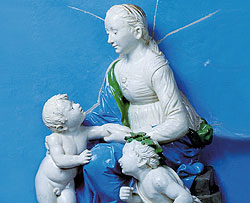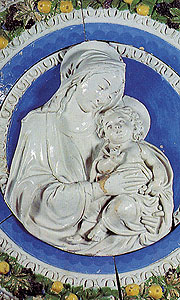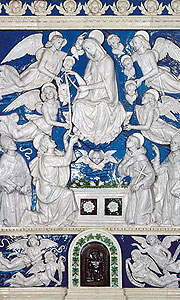|
"I Della Robbia" Exhibition - Arezzo
|
|
 I Della Robbia
I Della Robbia
The Dialogue Between the Arts in the Renaissance
21st February 2009 – 7th June 2009
Arezzo, Museo Statale D'Arte Medievale e Moderna
The intense activity of the Della Robbia family lasted a very long time, from the early
decades of the 15th century to way beyond the second half of the 16th century: more than one
hundred years which permanently influenced modern Western culture.
The exhibition, opening on 21st February 2009 in Arezzo, and dedicated to this famous
family of artists, will therefore be the opportunity to retrace plots, relationships, contests
and, above all, to underline the close dialogue between all the arts which was the base of
the Renaissance.
Not only the multifaceted and fascinating story of the ‘robbiana’ glazed earthenware art
during the Renaissance, between 1430 and about 1580 - from Luca della Robbia’s ingenious
“invention” to the extraordinary progress of this “new, useful and beautiful art” – but, most
of all, and for the first time in an exhibition, its constant and rich “dialogue” with the “three
sister arts” (sculpture, painting and architecture) and with the varied world of the so-called
“decorative arts” (majolica, china, mosaic, glass, enamels, goldsmith’s art, marble and wood
inlays, fabrics, prints etc.).
 Thus, earth becomes glass, sculpture is mixed with painting, it communicates with the
goldsmith’s art, and captures the dazzling flashes of rock crystals and of mosaics in the
“caprices” of the Della Robbia family, creators and interpreters of a new art, a combination
of creativity, technique and craftsmen’s experience, whose original formula was kept
strenuously secret for many, many years. Thus, earth becomes glass, sculpture is mixed with painting, it communicates with the
goldsmith’s art, and captures the dazzling flashes of rock crystals and of mosaics in the
“caprices” of the Della Robbia family, creators and interpreters of a new art, a combination
of creativity, technique and craftsmen’s experience, whose original formula was kept
strenuously secret for many, many years.
So in Arezzo, after Piero della Francesca, there will soon be another exceptional event,
promoted by the Provincia di Arezzo, in collaboration with Comune di Arezzo, Regione
Toscana, Camera di Commercio, Industria, Artigianato e Agricoltura di Arezzo, Banca
Etruria, Soprintendenza per i Beni Architettonici e per il Paesaggio, per il Patrimonio
Storico, Artistico ed Etnoantropologico per la Provincia di Arezzo and with the support of
Toscana Promozione and Agenzia per il Turismo di Arezzo (Arezzo Tourist Board). This
exhibition will help you to rediscover an art intimately connected to its area, as you can see
by the continual presence of the Della Robbia family in its churches, in its ‘palazzi’, and in
the Tuscan cities architecture of the times, and so you will be able to relive the artistic epic
of a century.
Next to the extraordinary works by Luca, Andrea, Giovanni and Girolamo Della Robbia,
you will be able to see the works created by other artists of this period, with whom they
compared themselves in a profitable relationship ‘of giving and receiving’: Donatello,
Ghiberti, Andrea del Verrocchio, Rossellino, Pisanello, Filippo Lippi, Ghirlandaio, Perugino,
Desiderio da Settignano, Fra’ Bartolomeo, Sansovino, Fra’ Carnevale, etc.
Carefully arranged by Giancarlo Gentilini and Liletta Fornasari and organized by Villaggio
Globale International, with a Scientific Committee of the highest level, amongst whom are
Cristina Acidini, Gabriele Borghini, Aldo Cicinelli, Maria Teresa Filieri, Vittoria Garibaldi,
Mario Lolli Ghetti, Beatrice Paolozzi Strozzi, Antonio Paolucci, Bruno Santi – the
exhibition’s starting point is the experience of Luca della Robbia. Leon Battista Alberti
described him as being one of the Fathers of the Renaissance, who showed in his innovative
“glazed paintings and sculptures” that he was capable of mixing and merging various art
forms (stone sculpture tradition with the reborn clay sculpture, practice in “drawing” and
therefore in painting, with mosaic decoration, goldsmith enamels with sophisticated
oriental china), creating and initiating an original ‘genre’, unknown even in ancient times
and which was a masterful and unequalled form of ceramic art, so that his works are truly
“eternal and brilliant”.
 The arrangement of the exhibition for this event in Arezzo, which will also display some
exceptional unknown works, is thus divided into thematic and typological sections, so that
the characteristics, meanings, and the most distinguishing artistic and historical
implications of the ‘robbiana’ art will be clearly demonstrated. The arrangement of the exhibition for this event in Arezzo, which will also display some
exceptional unknown works, is thus divided into thematic and typological sections, so that
the characteristics, meanings, and the most distinguishing artistic and historical
implications of the ‘robbiana’ art will be clearly demonstrated.
The basic theme is the “comparison” to painting which recalls many famous names: from
the acquaintance of Luca with Filippo Lippi and from his meetings with Pisanello and Fra’
Carnevale to that of Andrea della Robbia with Verrocchio, Perugino, Fra’ Bartolomeo, right
up to the challenge of the “modern manner” with the last Della Robbia generation working
and researching with Raffaello, Andrea del Sarto, Gerino da Pistoia.
Their relationship with sculptors is equally interesting and fascinating, from Ghiberti and
Donatello to Rustici and Sansovino; and with architects such as Benedetto da Maiano,
emphasized by the fact that the invention of glazed earthenware art seems to have been
sponsored and supported by Brunelleschi himself. In fact, he was interested in converting
the expressive and functional values of mosaics into sculpture and painting, experimenting
with ceramics an interesting and technical alternative to traditional mosaic art.
All the members of the Della Robbia family were perfectly integrated into their local
historical and artistic environment; they were actually amongst its most famous and
admired citizens. Their art spread widely all over the centre of Italy and even crossed the
Italian border, sought-after and greatly appreciated by the principal European courts. Thus
began the tradition that, starting from the workshop in “via Guelfa” in Florence, can now
be seen in the world’s most important museums, as is shown by the works of art on loan
from Berlin, Paris, Rouen, St. Petersburg, and so on.
Therefore, this is an ambitious and totally new exhibition which will allow visitors to
reinterpret and to gain a deeper understanding into the meaning and value of an
extraordinary art that changed the appearances of Tuscan cities and of which there are still
many important examples in the Province of Arezzo.
This exhibition thus becomes the heart of a route that takes you across this area - through
the Casentino, Valdarno, Valdichiana and Valtiberina valleys – in various, extremely
evocative itineraries where art and nature entwine together in a wonderfully fascinating
combination.
Official Website: www.mostradellarobbia.it
|


